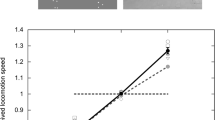Abstract
It has been shown that active control of locomotion increases accuracy and precision of nonvisual space perception, but psychological mechanisms of this enhancement are poorly understood. The present study explored a hypothesis that active control of locomotion enhances space perception by facilitating crossmodal interaction between visual and nonvisual spatial information. In an experiment, blindfolded participants walked along a linear path under one of the following two conditions: (1) They walked by themselves following a guide rope and (2) they were led by an experimenter. Subsequently, they indicated the walked distance by tossing a beanbag to the origin of locomotion. The former condition gave participants greater control of their locomotion and thus represented a more active walking condition. In addition, before each trial, half the participants viewed the room in which they performed the distance perception task. The other half remained blindfolded throughout the experiment. Results showed that although the room was devoid of any particular cues for walked distances, visual knowledge of the surroundings improved the precision of nonvisual distance perception. Importantly, however, the benefit of preview was observed only when participants walked more actively. This indicates that active control of locomotion allowed participants to better utilize their visual memory of the environment for perceiving nonvisually encoded distance, suggesting that active control of locomotion served as a catalyst for integrating visual and nonvisual information to derive spatial representations of higher quality.

Similar content being viewed by others
References
Philbeck JW, O’Leary S (2005) Remembered landmarks enhance the precision of path integration. Psicológica 26:7–24
Philbeck JW, Klatzky RL, Behrmann M, Loomis JM, Goodridge J (2001) Active control of locomotion facilitates nonvisual navigation. J Exp Psychol Hum Percept Perform 27:141–153. doi:10.1037/0096-1523.27.1.141
Rieser JJ (1999) Dynamic spatial orientation and the coupling of representation and action. In: Golledge RG (ed) Wayfinding behavior: cognitive mapping and other spatial processes. Johns Hopkins University Press, Baltimore, pp 168–190
Sahm CS, Creem-Regehr SH, Thompson WB, Willemsen P (2005) Throwing versus walking as indicators of distance perception in similar real and virtual environments. ACM Trans Appl Percept 2:35–45. doi:10.1145/1012551.1012600
Acknowledgments
This research was supported in part by Cleveland State University Research and Creative Achievement Award. The author thanks Adam Woods for comments on a draft of this article and Dagmara Mach, Govind Sailesh Pappu, Lucinda Rohde, and Jessica Willesch for assistance with data collection.
Conflict of interest
This supplement was not sponsored by outside commercial interests. It was funded entirely by ECONA, Via dei Marsi, 78, 00185 Roma, Italy.
Author information
Authors and Affiliations
Corresponding author
Rights and permissions
About this article
Cite this article
Yamamoto, N. The role of active locomotion in space perception. Cogn Process 13 (Suppl 1), 365–368 (2012). https://doi.org/10.1007/s10339-012-0462-z
Published:
Issue Date:
DOI: https://doi.org/10.1007/s10339-012-0462-z




